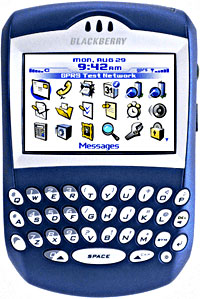 Like the Black Knights in Monty Python’s ‘Holy Grail,’ PDAs are refusing to be beaten, despite almost monthly declarations of their impending obsolescence.
Like the Black Knights in Monty Python’s ‘Holy Grail,’ PDAs are refusing to be beaten, despite almost monthly declarations of their impending obsolescence.
Far from shuffling off into that big technology dustbin in the sky (or, more likely, some landfill site somewhere), Personal Digital Assistants managed to register the highest PDA shipment total of any second quarter on record.
The new research from Gartner saw PDA shipments totalling 3.7 million units in the second quarter of 2006, up 2.7 percent from the second quarter of 2005.
Much of the growth is coming from GPS-enabled new kids on the PDA block like Mio Technology, Motorola and Danger Research, while old boys like Research In Motion (RIM), Palm, Hewlett-Packard and Dell all saw steadily declining shipments.
When it comes to PDA operating systems, Microsoft’s Windows Mobile kept pushing ahead with 54.2 percent of PDA OS shipments, followed by RIM OS with 22.5 percent of the market and Palm OS with 13.4 percent.
“The ongoing integration of WAN technology into PDAs, and the marketing push of these devices by wireless operators has produced most of the growth compared to one year ago,” said Todd Kort, principal analyst in Gartner’s Computing Platforms Worldwide group.
Although shipments are up, revenues are down, as Kort explained: “The average selling price of PDAs fell by 6 percent from one year ago to $373, mostly due to aging product lines, the increasing impact of wireless operator subsidies and relatively few new PDAs being launched thus far in 2006.”
 This explains how worldwide PDA end-user revenue fell by 4.1 percent last year to $1.38 billion in the second quarter of 2006.
This explains how worldwide PDA end-user revenue fell by 4.1 percent last year to $1.38 billion in the second quarter of 2006.
The report breaks down PDA shipments by manufacturer, Q2 2006 shipment estimates, market share and 2Q05- 1Q06 growth.
Research In Motion 830,720 shipments, 22.5% market share, -1.1% growth
Palm 470,458 , 12.7%, -26.7%
Hewlett-Packard 382,653, 10.4% -15.1%
Mio Technology 303,377, 8.2% 65.4%
Nokia 163,600, 4.4%, -40.5%
Others 1,545,596, 41.8%, 27.8%
It’s worth noting that these totals don’t include smartphones, such as the hugely popular Palm Treo phones (which shifted 656,000 units over the same quarter) and BlackBerry 71xx (467,000 units excluded), but include cellular PDAs, such as the iPAQ 69xx and Nokia E61.
Which rather makes the results a bit confusing to our eyes.
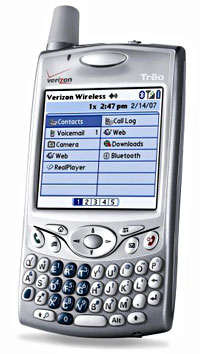 For a self confessed, gimme-gimme-shiny-new gadgets nutcase like me to be using a phone several years old speaks volumes of the strengths of the Treo 650.
For a self confessed, gimme-gimme-shiny-new gadgets nutcase like me to be using a phone several years old speaks volumes of the strengths of the Treo 650. If I’d have taken my Windows Mobile phone I dare say I would have been very well acquainted with stylus (and the reset button) by this time, but the Treo’s fabulous one-handed operation and rock solid performance made it a practical laptop replacement.
If I’d have taken my Windows Mobile phone I dare say I would have been very well acquainted with stylus (and the reset button) by this time, but the Treo’s fabulous one-handed operation and rock solid performance made it a practical laptop replacement.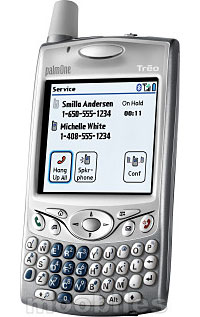 Palm has remained tight-lipped about their European product roadmap, with the web rife with rumours of both Windows and Palm new models going under ggroovy codenames like Hollywood, Lowrider, Nitro and Lennon.
Palm has remained tight-lipped about their European product roadmap, with the web rife with rumours of both Windows and Palm new models going under ggroovy codenames like Hollywood, Lowrider, Nitro and Lennon. The mobile division of TV production company Twofour and Player One Sports are working together to create a weekly short form TV show covering the Australian portion of the Ashes tour for portable devices.
The mobile division of TV production company Twofour and Player One Sports are working together to create a weekly short form TV show covering the Australian portion of the Ashes tour for portable devices. Vodafone is hotly denying that its enthusiasm for 3G has waned, after rumours began circulating that the operator was cutting handset subsidies and abandoned all hope of the technology ever becoming a lucrative commercial success.
Vodafone is hotly denying that its enthusiasm for 3G has waned, after rumours began circulating that the operator was cutting handset subsidies and abandoned all hope of the technology ever becoming a lucrative commercial success.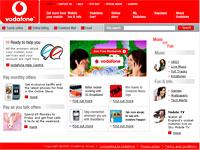 Video calling
Video calling Not surprisingly, the UK’s only 3G-only network, 3, were quick to quibble about the claims, insisting that the wild popularity of their downloadable music and mobile TV services is proof positive that the demand is there – if the technology is marketed correctly.
Not surprisingly, the UK’s only 3G-only network, 3, were quick to quibble about the claims, insisting that the wild popularity of their downloadable music and mobile TV services is proof positive that the demand is there – if the technology is marketed correctly.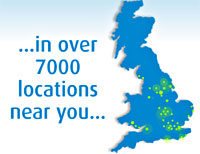 UK regulator Ofcom is looking at plans to introduce high speed Internet access to broadband-starved remote areas by boosting the power of Wi-Fi signals.
UK regulator Ofcom is looking at plans to introduce high speed Internet access to broadband-starved remote areas by boosting the power of Wi-Fi signals. City networks
City networks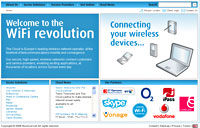 Ruckus, who are currently working with Google to test a free mesh network in Mountain View, California, have developed a new Wi-Fi antenna to help home users connect to city networks.
Ruckus, who are currently working with Google to test a free mesh network in Mountain View, California, have developed a new Wi-Fi antenna to help home users connect to city networks. Well they got there finally, Vodafone UK have announced that they’re releasing the less than catchy named Vodafone Mobile Connect USB Modem in the Autumn. It will support their 3G data service and, surprise, surprise, connect to computers using a USB lead. Rather neatly the software disks aren’t needed, as they’re installed directly from the modem.
Well they got there finally, Vodafone UK have announced that they’re releasing the less than catchy named Vodafone Mobile Connect USB Modem in the Autumn. It will support their 3G data service and, surprise, surprise, connect to computers using a USB lead. Rather neatly the software disks aren’t needed, as they’re installed directly from the modem.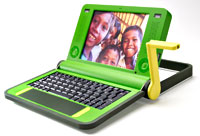 Yesterday, a spokesperson for the One Laptop Per Child (OLPC) programme revealed that Nigeria, Brazil, Argentina, and Thailand have all tendered commitments to purchase one million Linux laptops through the ambitious US-based programme.
Yesterday, a spokesperson for the One Laptop Per Child (OLPC) programme revealed that Nigeria, Brazil, Argentina, and Thailand have all tendered commitments to purchase one million Linux laptops through the ambitious US-based programme.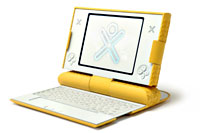 This means that each laptop will be able to talk to its nearest neighbour and create ad hoc, local area networks for sharing data and connections.
This means that each laptop will be able to talk to its nearest neighbour and create ad hoc, local area networks for sharing data and connections.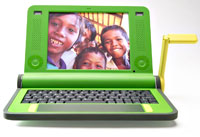 So far, AMD, eBay, Google, Nortel, Red Hat, and a number of other technology companies have all signed up to help support the project
So far, AMD, eBay, Google, Nortel, Red Hat, and a number of other technology companies have all signed up to help support the project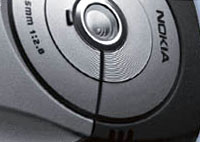 Global sales of handsets are set to reach 1.5 billion in five years, according to a new report by IT research firm Analysys.
Global sales of handsets are set to reach 1.5 billion in five years, according to a new report by IT research firm Analysys. Ball rubbing
Ball rubbing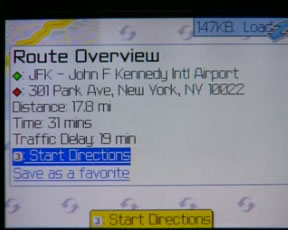 The ever-expanding selection of Google features just grew by one as they announce that they’re providing Live Traffic updates to mobile phones in 30 US cities and partial information in many others.
The ever-expanding selection of Google features just grew by one as they announce that they’re providing Live Traffic updates to mobile phones in 30 US cities and partial information in many others.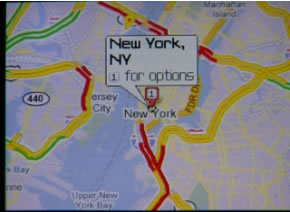 Google are slightly playing catchup with Yahoo on this one, as they been plotting live traffic on Yahoo Maps since March 2005.
Google are slightly playing catchup with Yahoo on this one, as they been plotting live traffic on Yahoo Maps since March 2005. On the back of the Mobile Maps news, Google also announced that users now have the ability to customize the content that appears on the mobile version of their Personalized Homepage, making it even easier for mobile phone users to quickly get the information they need when away from their computers.
On the back of the Mobile Maps news, Google also announced that users now have the ability to customize the content that appears on the mobile version of their Personalized Homepage, making it even easier for mobile phone users to quickly get the information they need when away from their computers. In the largest UK study of its kind, the Mobile Life Report has revealed our attitudes towards mobile phones and how they have impacted on our lives, with more than 90% of UK mobile users saying they can’t get through the day without using their phone.
In the largest UK study of its kind, the Mobile Life Report has revealed our attitudes towards mobile phones and how they have impacted on our lives, with more than 90% of UK mobile users saying they can’t get through the day without using their phone.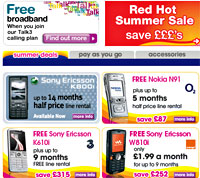 Lord knows why people bothered to answer these questions, but the survey found that a quarter of people bothered to disconnect their mobiles before indulging in a bit of hanky panky, with 11% switching them to silent (writer resists cheap joke about vibra-alerts) and 14% turning their phones off altogether.
Lord knows why people bothered to answer these questions, but the survey found that a quarter of people bothered to disconnect their mobiles before indulging in a bit of hanky panky, with 11% switching them to silent (writer resists cheap joke about vibra-alerts) and 14% turning their phones off altogether.